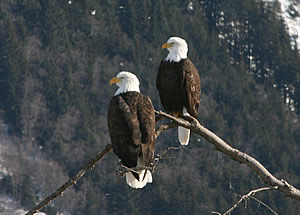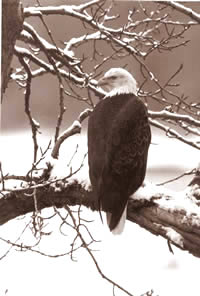 An American bald eagle perched in a tree in the Chilkat Bald Eagle Preserve.
An American bald eagle perched in a tree in the Chilkat Bald Eagle Preserve.Almost 4,000 American bald eagles gather along a 5-mile stretch of the Chilkat River near Haines and Klukwan, Alaska each fall. This great wildlife spectacle is the largest gathering of bald eagles in the world. Attracted by a late run of spawning chum salmon, eagles come from all over Alaska, British Columbia, and as far away as the state of Washington. Warm water upwellings in the river bottom keep some stretches of the Chilkat ice-free through the winter, providing a diet of salmon carcasses when food supplies elsewhere are exhausted. Starting in late October, hundreds and hundreds of eagles can be seen along the sandbars or in nearby cottonwood trees. Two dozen or more eagles in a single tree are not uncommon.
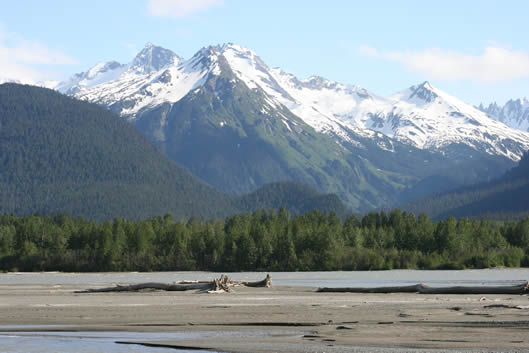
The Chilkat Bald Eagle Preserve in summer, backed by the soaring Chilkat Mountains.
The Tlingits were the first known human inhabitants of the Valley of the Eagles. The great gathering of eagles has occurred at least as far back as Native man’s earliest memories of the area. The people of Klukwan, the “mother village” located next to the gathering area, have always lived in a close relationship to the eagle, an important part of Tlingit culture. The eagles of the Chilkat Preserve are perhaps the most tolerant of human presence of any in North America. This may be attributed to the fact that for thousands of years both eagles and human beings have cohabited in the Chilkat Valley. Eagles and Tlingits have historically shared the natural wealth of the valley. At times as many as 5,000 Tlingits resided in the valley and the presence of man has perhaps habituated the bald eagle here, making this area a strong attraction for wildlife photographers and visitors wishing to observe eagle behavior.
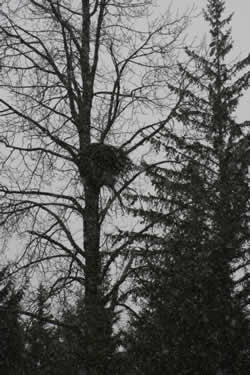
An eagle’s nest.
When the eagles come to the Chilkat and how long they stay varies from year to year depending on food availability and weather. Usually, the height of the gathering is in November, with the number of eagles dwindling by February. The Valley of the Eagles is year-round home for up to 200 resident eagles, so there’s a good chance of sighting them even in the summer–perched high in trees, sitting along beaches or river banks, soaring on the prevailing winds, or guarding their nests. In summer the Tsirku River delta is often the site of most eagle activity, due to the sockeye salmon run enroute to Chilkat Lake.
The Alaska Bald Eagle Preserve contains 48,000 acres set aside for the protection of the eagles. The establishment of this preserve is fairly recent, unique, and has an interesting history involving much controversy. The hard work and cooperation of many local individuals and others ultimately created the Preserve.
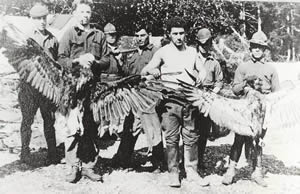
A group of seven Fort Seward soldiers holding up bald eagle carcasses. An estimated 128,000 eagles were killed between 1917 and 1953 for a bounty of fifty cents to two dollars, circa 1920.
The eagle itself has a history of being controversial in Alaska and elsewhere. At one time, fishermen accused eagles of competing for and causing the decline of salmon fisheries in Alaska and, to a lesser degree, in the rest of the Northwest. In 1917, the Alaska Territorial Legislature established a bounty on eagles. In 1953, eagles were still fair game with a bounty of fifty cents to two dollars paid for each pair of eagle feet presented. Many Alaskan residents made their spending money from this bounty. During those 36 years over 128,000 eagles were killed.
Since 1953, when the territorial legislature removed the bounty because of the lack of evidence that eagles caused the decline of salmon, the eagle population began to increase again, nearly doubling in the 1970s from what it was in 1940. From 1953 to1959 the Department of Interior had the responsibility for protecting the bald eagle in Alaska. When Alaska became a state in 1959, bald eagles finally came under the protection of the National Bald Eagle Act of June 8, 1940.
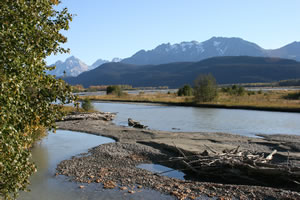
Another summer scene from the Preserve.
In 1959, a plan to develop the iron ore deposits around Klukwan on the Chilkat River was proposed by a mining consortium. The plan would have diverted the river and disposed of mine tailings over approximately 3,840 acres of flood plan in some of the Chilkat bald eagle’s most critical habitat. The plan was dropped to unprofitability in 1960. At this time the U.S. Fish and Wildlife Service initiated annual counts of the Chilkat eagles.
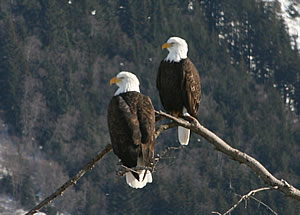
Two eagles perched on a deadfall limb.
In the early 1970s, some eagle protection advocates sought endorsement of a Chilkat National Wildlife Refuge. Although this effort failed, the process did lead to increased awareness of the importance of the Chilkat area to bald eagles. The Alaska Legislature established the Chilkat River Critical Habitat in 1972. This decreed that any use or management of the area could not and must not harm the eagle populations or their habitat. This declaration caused major controversy due to the number and diversity of resource utilizations, including logging and mining.
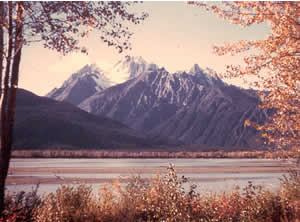
Locally known as the “Cathedral Peaks,” these tall spires are part of the Chilkat Range which can be seen from the Preserve.
From 1976 to 1978, the Wilderness Research Institute performed a more in-depth and intensive population revealing that the Chilkat Bald Eagle concentration was the largest known in North America and the world. (As of 2012, there are several places in North America with large bald eagle populations, but the Chilkat area remains one of the highest). A proposal to make the area a state park in 1977 was abandoned after receiving intense opposition from logging interests. In 1979, the State entered into a contract with a local logging company that would have made virtually the entire Chilkat valley available for large-scale, clear-cut logging. Conservationists began a long, legal intervention. In 1979, the National Audubon Society initiated a four-year study in conjunction with the U.S. Fish and Wildlife Service. A Haines-Skagway land use plan came under serious scrutiny, and the local community was polarized regarding the logging versus eagle protection controversy.
In 1981, the communities of Klukwan and Haines in conjunction with the State of Alaska initiated a new study known as the Haines-Klukwan Cooperative Resource Study. From 1981 to 1983, issues were being argued in the court arena. During this period, a compromise solution began to take shape which resulted in Alaska Senate Bill 796 being signed into law by Governor Jay Hammond, establishing the 48,000 acre Chilkat Bald Eagle Preserve, and the adjacent Haines State Forest Resource Management Area. This agreement guaranteed that the local residents have certain prescriptive and traditional rights to use the preserve in its entirety. Hunting, fishing, trapping, berry picking, and woodcutting are a few of these rights that are protected by law within the preserve.
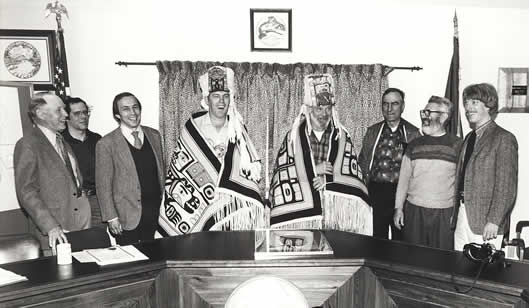
Participants in the signing of the Chilkat Bald Eagle Preserve Bill, June, 1982. From left to right: Bob Henderson, unknown, unknown, Mayor Jon Halliwill, unknown, John Schnabel, Ray Menaker, and unknown. If you can identify any unknown individuals please email.
The Alaska Chilkat Bald Eagle Preserve Advisory Council was also established by this legislation to oversee management of the Preserve, which encompasses parts of both the Chilkat and Chilkoot watersheds. The Alaska Chilkat Bald Eagle Preserve Advisory Council is composed of 12 seats representing conservation, business and industry, Upper Lynn Canal Fish and Game Advisory Committee, the mayor of the City of Haines, the mayor of the Borough of Haines, the president of Klukwan, Inc., the chairman of the Council of the Chilkat Indian Village, the Chairman of the Chilkoot Indian Association, The Commissioner of the Department of Fish and Game, the Director of the Division of Parks and Outdoor Recreation, the Director of the Division of Forestry, and the U.S. Fish and Wildlife Service.
SB 796, now Alaska Statute 41.21.610-41.21.630, clearly states the Legislative intent in establishing the preserve. “The primary purpose of establishing the Alaska Chilkat Bald Eagle Preserve is to perpetuate the Chilkat bald eagles and the essential habitat within the Alaska Chilkat Bald Eagle Preserve in recognition of their statewide, nationally, and internationally significant values in perpetuity.”
The bill further states that the Preserve is also established to:
- Protect and sustain the natural spawning and rearing areas of the Chilkat River and Chilkoot River systems within the Preserve in perpetuity.
- Provide continued opportunities for research and study, and enjoyment of bald eagles and other wildlife.
- Ensure to the maximum extent practical water quality and necessary water quantity under applicable laws.
- Control, development and maintenance is assigned to the Alaska Department of Natural Resources under the Division of Parks. Additionally, the Alaska Department of Fish and Game has the legislatively mandated responsibility to maintain the Chilkat Bald Eagle Council Grounds through the creation of the Chilkat River Critical Habitat Area, Alaska Statute 16.20.230 SLA 1972.
SB 796 represented a benchmark in environmental legislation and cooperative compromise between resource development and environmental managers by recognizing the significant value of meaningful local involvement. Many people representing many different interests were involved in the drafting and passing of this legislation. A consensus of local, regional, state and national efforts had indeed prevailed and the first and only Alaska State Wildlife Preserve was formed. The Alaska Chilkat Bald Eagle Preserve was finally a reality.
The Alaska Chilkat Bald Eagle Preserve Foundation, a separate entity, is a federally recognized non-profit Alaskan corporation founded and formed by Ray Menaker, Dick Folta, John Bruce, Bruce Gilbert, Norm Blank, Dan Turner, and Erich von Stauffenberg. The purpose of the Foundation is to assist in protecting the bald eagles of the area by developing research, educational, and visitor accommodation programs.
The American Bald Eagle Foundation, another distinct entity, founded by Dave Olerud, has a building located in Haines with a natural diorama exhibiting local wildlife and live birds. The purpose of this federally recognized non-profit organization is to provide educational facilities materials for people who wish to learn more about the American Bald Eagle and its habitat, both locally and nationally.
Kathleen Menke, 1997
Bibliography:
- Alaska Chilkat Bald Eagle State of the Preserve Report, 1993.
- Hansen, Andrew J., Boeker, Erwin L., Hodges, John I., and Cline, David R., Bald
- Eagles of the Chilkat Valley, Alaska, National Audubon Society and U.S. Fish and Wildlife Service, 1984.
- Menaker, Ray and Staska, Ray, Alaska Chilkat Bald Eagle Preserve Foundation directors, and von Stauffenberg, Erich (Foundation CEO); interviews by Kathleen Menke, 1995-1997.
- Olerud, Dave, American Bald Eagle Foundation; interviews by Kathleen Menke, 1995,1996.
- Sheldon Museum Bald Eagle Preserve Brochure

